The NVIDIA GeForce GTX 980 Ti Review
by Ryan Smith on May 31, 2015 6:00 PM ESTCompute
Shifting gears, we have our look at compute performance. Since GTX Titan X has no compute feature advantage - no fast double precision support like what's found in the Kepler generation Titans - the performance difference between the GTX Titan X and GTX 980 Ti should be very straightforward.
Starting us off for our look at compute is LuxMark3.0, the latest version of the official benchmark of LuxRender 2.0. LuxRender’s GPU-accelerated rendering mode is an OpenCL based ray tracer that forms a part of the larger LuxRender suite. Ray tracing has become a stronghold for GPUs in recent years as ray tracing maps well to GPU pipelines, allowing artists to render scenes much more quickly than with CPUs alone.
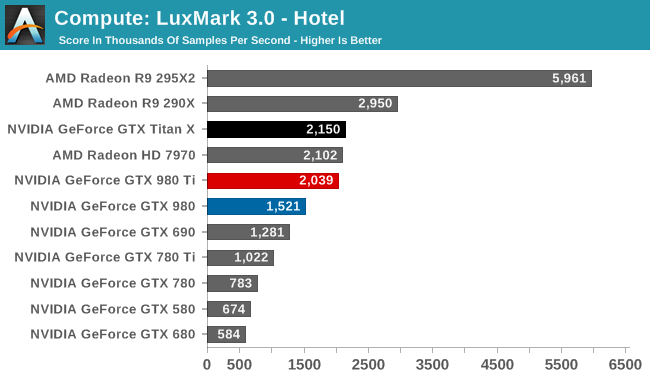
With the pace set for GM200 by GTX Titan X, there’s little to say here that hasn’t already been said. Maxwell does not fare well in LuxMark, and while GTX 980 Ti continues to stick very close to GTX Titan X, it none the less ends up right behind the Radeon HD 7970 in this benchmark.
For our second set of compute benchmarks we have CompuBench 1.5, the successor to CLBenchmark. CompuBench offers a wide array of different practical compute workloads, and we’ve decided to focus on face detection, optical flow modeling, and particle simulations.
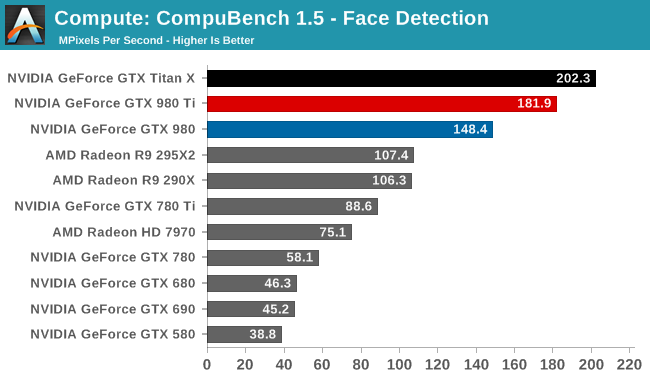
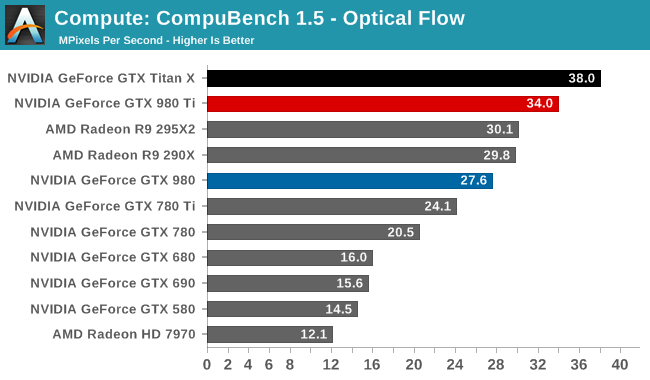
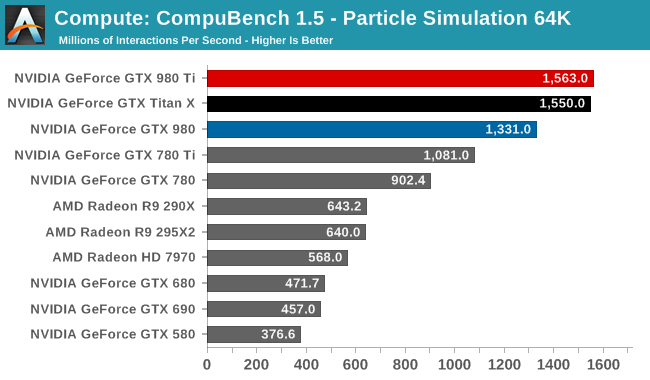
Although GTX T980 Ti struggled at LuxMark, the same cannot be said for CompuBench. Though taking the second spot in all 3 sub-tests - right behind GTX Titan X - there's a bit wider of a gap than normal between the two GM200 cards, causing GTX 980 Ti to trail a little more significantly than in other tests. Given the short nature of these tests, GTX 980 Ti doesn't get to enjoy its usual clockspeed advantage, making this one of the only benchmarks where the theoretical 9% performance difference between the cards becomes a reality.
Our 3rd compute benchmark is Sony Vegas Pro 13, an OpenGL and OpenCL video editing and authoring package. Vegas can use GPUs in a few different ways, the primary uses being to accelerate the video effects and compositing process itself, and in the video encoding step. With video encoding being increasingly offloaded to dedicated DSPs these days we’re focusing on the editing and compositing process, rendering to a low CPU overhead format (XDCAM EX). This specific test comes from Sony, and measures how long it takes to render a video.

Traditionally a benchmark that favors AMD, GTX 980 Ti fares as well as GTX Titan X, closing the gap some. But it's still not enough to surpass Radeon HD 7970, let alone Radeon R9 290X.
Moving on, our 4th compute benchmark is FAHBench, the official Folding @ Home benchmark. Folding @ Home is the popular Stanford-backed research and distributed computing initiative that has work distributed to millions of volunteer computers over the internet, each of which is responsible for a tiny slice of a protein folding simulation. FAHBench can test both single precision and double precision floating point performance, with single precision being the most useful metric for most consumer cards due to their low double precision performance. Each precision has two modes, explicit and implicit, the difference being whether water atoms are included in the simulation, which adds quite a bit of work and overhead. This is another OpenCL test, utilizing the OpenCL path for FAHCore 17.
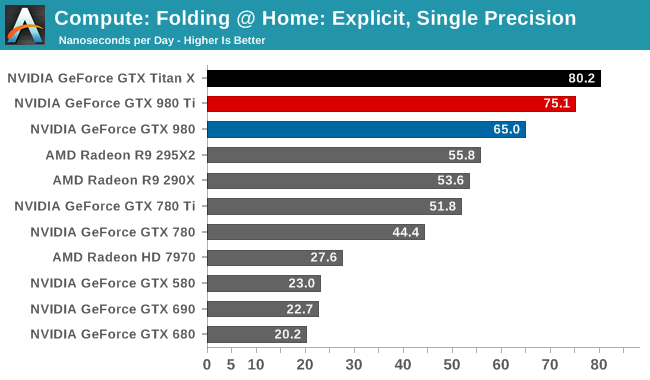
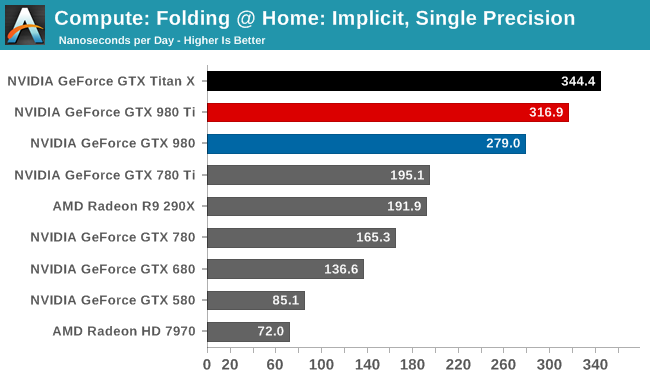
Folding @ Home’s single precision tests reiterate GM200's FP32 compute credentials. Second only to GTX Titan X, GTX 980 Ti fares very well here.
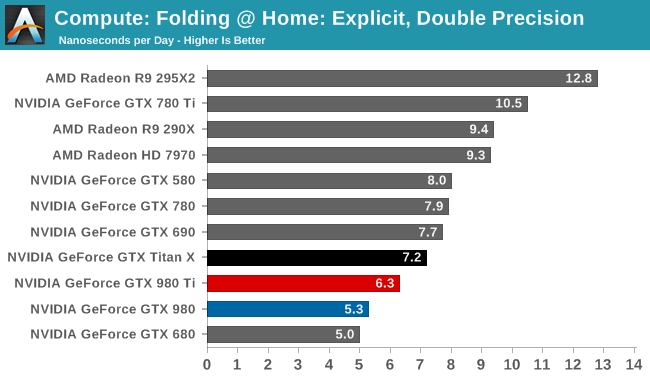
Meanwhile Folding @ Home’s double precision test reiterates GM200's poor FP64 compute performance. At 6.3ns/day, it, like the GTX Titan X, occupies the lower portion of our benchmark charts, below AMD's cards and NVIDIA's high-performnace FP64 cards.
Wrapping things up, our final compute benchmark is an in-house project developed by our very own Dr. Ian Cutress. SystemCompute is our first C++ AMP benchmark, utilizing Microsoft’s simple C++ extensions to allow the easy use of GPU computing in C++ programs. SystemCompute in turn is a collection of benchmarks for several different fundamental compute algorithms, with the final score represented in points. DirectCompute is the compute backend for C++ AMP on Windows, so this forms our other DirectCompute test.

We end up ending our benchmarks where we started: with the GTX 980 Ti slightly trailing the GTX Titan X, and with the two GM200 cards taking the top two spots overall. So as with GTX Titan X, GTX 980 Ti is a force to be reckoned with for FP32 compute, which for a pure consumer card should be a good match for consumer compute workloads.










290 Comments
View All Comments
Klimax - Tuesday, June 2, 2015 - link
Just small bug in your article:Page "GRID Autosport" has one paragraph from previous page.
"Switching out to another strategy game, even given Attila’s significant GPU requirements at higher settings, GTX 980 Ti still doesn’t falter. It trails GTX Titan X by just 2% at all settings."
As for theoretical pixel test with anomalous 15% drop from Titan X, there is ready explanation:
Under specific conditions there won't be enough power to push those two Raster engines with cut down blocks. (also only three paths instead of four)
Ryan Smith - Wednesday, June 3, 2015 - link
Fixed. Thanks for pointing that out.bdiddytampa - Tuesday, June 2, 2015 - link
Really great and thorough review as usual :-) Thanks Ryan!Hrobertgar - Tuesday, June 2, 2015 - link
Today, Alienware is offering 15" laptops with an option for an R9-390x. Their spec sheet isn't updated, nor could I find updated specs for anything other than R9-370 on AMD's own website. Are you going to review some of these R9-300 series cards anytime soon?Hrobertgar - Tuesday, June 2, 2015 - link
When I went to checkout (didn't actually buy - just checking schedule) it indicated 6-8 day shipping with the R9-390X.3DJF - Tuesday, June 2, 2015 - link
Ummm....$599 for R9 295X2?......where exactly? every search i have done for that card over the last 4 months up to today shows a LOWEST price of $619.Ryan Smith - Wednesday, June 3, 2015 - link
It is currently $599 after rebate over at Newegg.Casecutter - Tuesday, June 2, 2015 - link
From most result the 980Ti offer 20% more @1440p than a 980 (GM204) and given the 980Ti cost like 18-19% more that the orginal MSRP of the 980 ($550) It's really not any big thing.Given GM200 a 38% larger die, and 38% more SU's over a GM204 and you get 20% increase? It worse when a full TitanX is considered, that has 50% more SU's and the TitanX get perhaps 4% more in FpS over the 980Ti. This points to the fact that Maxwell doesn't scale. Looking at power the 980Ti is needing approx. 28% more power, which is not the worst but is starting to indicate there a losses as Nvidia scaled it up.
chizow - Tuesday, June 2, 2015 - link
Well, I guess its a good thing 980Ti isn't just 20% faster than the 980 then lol.CiccioB - Thursday, June 4, 2015 - link
This is obviously a comment by a frustrated AMD fan.Maxwell scales perfectly as you didn't consider the frequency it runs.
GM200 is 50% more than a GM204 in all resources. But those GPU run at about 0.86% of GM204 frequency (1250 vs 1075). If you can do simple math, you'll see that for any 980 results, if you multiply it by 1.5 and then for 0.86 (or directly for 1.3, that means 30% more) you'll find almost exactly the numbers the 980Ti bench shows.
Now that the new 980 $500 price, do the same and... yes, it is $650 for 980Ti.
Oh, the die size... let's see... 398mm^2of GM204 * 1.5 = 597mm^2 which compares almost exactly with the calculated 601m^2 of GM200.
Pretty simply. It shows everything scales perfectly in nvidia house. Seen custom cards are coming, we'll see GM200 going to 50% more than GM204 at same frequency. Yet these cards will consume a bit more, as expected.
You cannot say the same for AMD architecture though, as with smaller chips GCN is somewhat on par or even better with respect to nvidia for perf/mm^2, but as soon as real crunching power is requested GCN becomes extremely inefficient under the point of both perf/Watt or perf/mm^2.
If you tried to plant a doubt about the quality of this GM200 or Maxwell architecture in general, sorry, you choose the wrong architecture/chip/method. You simply failed.